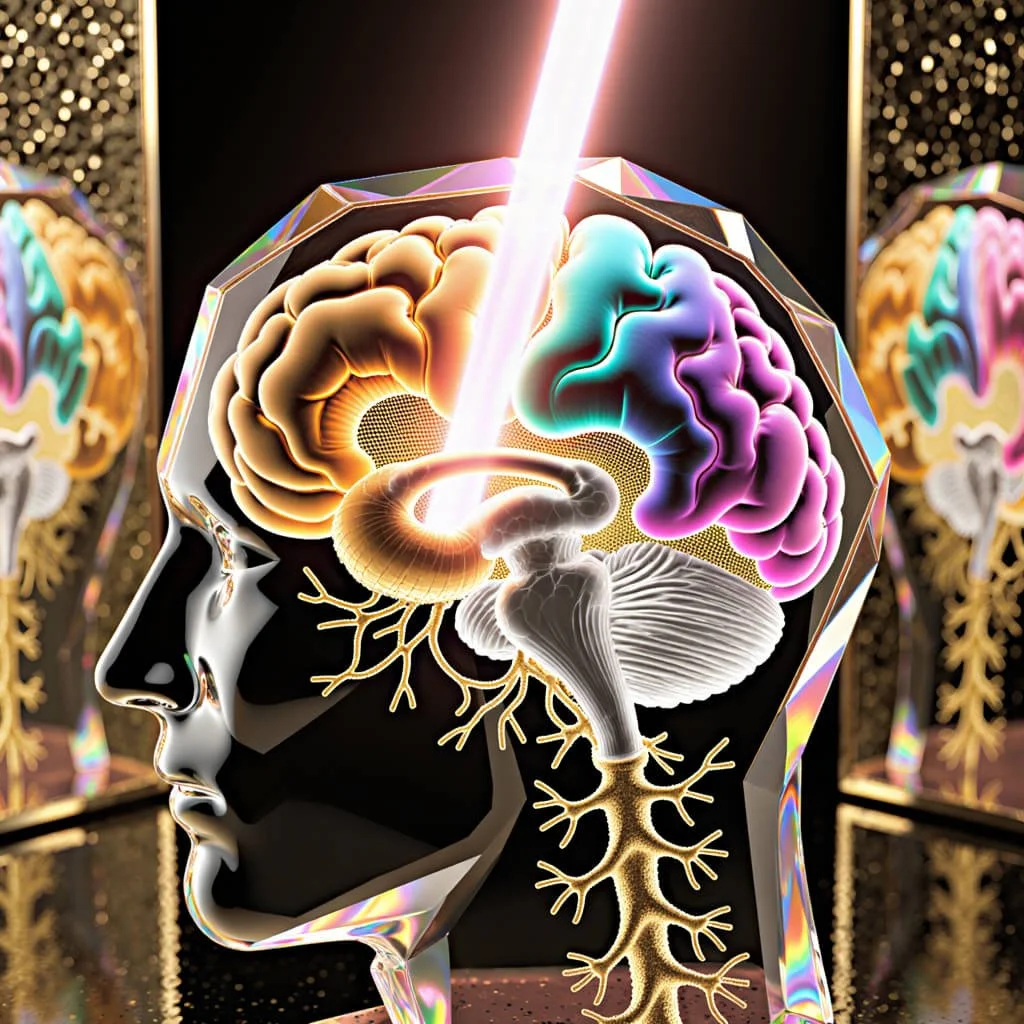Meditative Mind: The Neuroscience of the Burning Monk
The Meditative Mind of the Burning Monk: A Neuroscientific and Esoteric Analysis of Transcendent Human Consciousness
Monk on Fire by Malcolm Browne June 11th, 1963, Saigon, South Vietnam.
This comprehensive analysis examines the extraordinary act of self-immolation performed by Venerable Thich Quang Duc on June 11, 1963, through the dual lenses of contemporary neuroscience and ancient Buddhist wisdom traditions.
By integrating empirical research on meditation's neuroplastic effects with esoteric practices from Vajrayana Buddhism, martial arts traditions, and Asian mystical lore, this work illuminates the profound mechanisms underlying superhuman feats of consciousness control. The study reveals how decades of meditative practice can fundamentally rewire the brain's pain processing networks, attention systems, and autonomic responses, enabling transcendent states of awareness that defy conventional understanding of human physiological limitations.
Through examination of historical accounts, neuroimaging studies, and traditional practices, we construct a framework for understanding how the cultivated mind can achieve states of consciousness that transcend ordinary human experience, offering insights into the ultimate potentials of human consciousness and their implications for contemporary neuroscience and spiritual practice.
The image of Venerable Thich Quang Duc, seated in perfect stillness as flames consumed his physical form on June 11, 1963, represents one of the most profound demonstrations of human consciousness transcending physical limitation ever documented (Browne, 1963). This act, captured by Malcolm Browne's Pulitzer Prize-winning photograph, serves not merely as a historical artifact but as a window into the extraordinary capacities of the trained human mind. The complete absence of any visible distress, the maintenance of meditative posture, and the serene composure displayed during this ultimate sacrifice challenge our fundamental understanding of consciousness, pain perception, and the relationship between mind and body.
As contemporary neuroscience reveals the remarkable neuroplasticity of the human brain and the profound effects of contemplative practice on neural structure and function, we stand at the threshold of understanding mechanisms that could revolutionize our approach to pain management, mental health, and human potential (Davidson & Lutz, 2008). The burning monk's legacy offers a roadmap for exploring the furthest reaches of human consciousness while maintaining rigorous scientific methodology.
Historical Context and the Evolution of Meditation Science
Early Scientific Inquiry into "Human Hibernation"
The scientific investigation of extraordinary meditative states traces back to the 19th century, when early researchers encountered accounts of yogis demonstrating seemingly impossible feats of physiological control. These early inquiries, documented in prestigious journals such as The Lancet and Nature, revealed a profound skepticism toward practices that appeared to transcend known boundaries of human physiology (Müller, 1881). The dismissal of these phenomena as "Indian trickery" reflected the limitations of empirical frameworks that could not account for the sophisticated mind-body integration achieved through systematic contemplative practice.
Max Müller's seminal work "Thought and Breathing" (1881) provided crucial insights into the relationship between respiratory control and mental states, introducing Western scholarship to the Sanskrit Yoga-sûtras and the practice of prāṇāyāma. This early recognition of the symbiotic relationship between breath and consciousness laid the groundwork for understanding how advanced practitioners could achieve extraordinary states of physiological control through systematic respiratory manipulation.
The work of Ernst Leumann, a prominent Indologist, further illuminated the connection between cardiovascular function, breathing patterns, and mental states in meditation (Leumann, 1897). His pioneering investigations into the parallelism between pulse acceleration and states of consciousness provided early evidence for the neurophysiological basis of meditative phenomena, presaging contemporary research into the coherence of cardiac and respiratory functions during advanced meditation practice.
The Buddhist Crisis and Sacred Protest
The self-immolation of Thich Quang Duc occurred within the context of the Buddhist Crisis of 1963, a period of intense religious persecution under the Catholic Diem regime in South Vietnam. This act was not impulsive but represented a carefully considered expression of ultimate compassion and protest, deeply rooted in Buddhist principles of sacrificial love and the bodhisattva ideal (Topmiller, 2002). The monk's preparation for this act involved extensive meditation, fasting, and spiritual preparation that aligned with ancient practices designed to transcend physical attachment and achieve states of consciousness beyond ordinary human experience.
The global impact of this demonstration extended far beyond its immediate political context. President John F. Kennedy's response to the event acknowledged its profound symbolic power, while the image itself became an enduring symbol of the human capacity for transcendent consciousness in the face of ultimate suffering (Jones, 2003). The burning monk's demonstration catalyzed international awareness of both the political crisis in Vietnam and the extraordinary potential of human consciousness when cultivated through systematic spiritual practice.
Neuroplasticity and the Structural Foundations of Transcendent Consciousness
Meditation-Induced Structural Brain Changes
Contemporary neuroscience has revealed the remarkable capacity of intensive meditation practice to produce profound structural changes in the brain. Lazar et al. (2005) conducted seminal research demonstrating that experienced meditators with approximately nine years of consistent practice show significant increases in cortical thickness compared to matched controls. These changes were most pronounced in regions critical for attention, sensory processing, and pain modulation, including the anterior cingulate cortex (ACC) and anterior insula.
The ACC-fronto-periaqueductal gray (PAG) pathway identified by Lazar and colleagues represents a crucial neural network for pain modulation and cognitive control over nociceptive processing. This pathway enables top-down regulation of pain perception through descending modulatory inputs that can effectively attenuate nociceptive signals before they reach conscious awareness (Tracey & Mantyh, 2007). For an advanced practitioner like Thich Quang Duc, with over five decades of intensive meditation practice, these structural adaptations would have been profound, creating the neurobiological foundation for his extraordinary demonstration.
The anterior insula, recognized as a primary hub for interoceptive awareness, shows particularly pronounced changes in experienced meditators (Craig, 2009). This region integrates sensory information from throughout the body with emotional and cognitive processing, creating the subjective experience of embodied awareness. Enhanced structural integrity in this region may underlie the ability of advanced practitioners to maintain equanimous awareness even during intense physical sensations.
Age-Related Neuroplasticity and Meditation
Research has demonstrated that meditation practice can counteract age-related cortical thinning, suggesting that contemplative practice not only enhances neural structure but also preserves cognitive function throughout the lifespan (Luders et al., 2009). For elderly practitioners like Thich Quang Duc, who was 66 at the time of his self-immolation, this neuroprotective effect would have been particularly significant, maintaining the structural integrity necessary for the extraordinary cognitive control demonstrated during his final act.
The duration-dependent effects of meditation practice reveal a dose-response relationship between contemplative training and neural adaptation. Practitioners with longer meditation experience show more pronounced structural changes, suggesting that the extraordinary capacities demonstrated by advanced practitioners result from cumulative neuroplastic adaptations over decades of systematic practice (Lutz et al., 2004).
The Neuroscience of Pain Transcendence
Pain Processing Networks and Meditative Modulation
Understanding the burning monk's apparent imperviousness to pain requires examination of the complex neural networks involved in pain processing. The pain matrix, consisting of the primary and secondary somatosensory cortices, anterior cingulate cortex, insula, and thalamus, integrates sensory information about tissue damage with emotional and cognitive responses to create the subjective experience of pain (Melzack, 1999).
Research has demonstrated that meditation practice produces profound alterations in pain processing networks. Grant et al. (2010) found that experienced meditators show reduced activation in brain regions associated with the emotional and evaluative aspects of pain while maintaining sensory processing capacity. This suggests that meditation enables practitioners to experience the sensory aspects of painful stimuli without the typical emotional reactivity that amplifies suffering.
The mechanism underlying this pain modulation involves enhanced connectivity between cortical control regions and subcortical pain processing centers. The periaqueductal gray (PAG), a midbrain structure crucial for descending pain modulation, shows increased connectivity with the ACC in experienced meditators, suggesting strengthened top-down control over pain processing (Gard et al., 2012).
Altered States of Consciousness and Pain Perception
The burning monk's demonstration suggests access to altered states of consciousness that fundamentally transform the relationship between awareness and bodily sensation. These states, recognized in contemplative traditions as advanced meditative absorptions (jhanas or dhyanas), involve profound alterations in attention, bodily awareness, and the sense of self (Vago & Zeidan, 2016).
Neuroimaging studies of advanced meditators during deep absorptive states reveal decreased activity in the default mode network, a brain system associated with self-referential thinking and the maintenance of ordinary ego-consciousness (Brewer et al., 2011). This dissolution of ordinary self-awareness may underlie the ability to transcend typical pain responses, as the usual psychological mechanisms that amplify suffering become temporarily suspended.
Respiratory Control and Autonomic Mastery
The Physiology of Meditative Breathing
The burning monk's maintenance of meditative posture and apparent lack of autonomic stress responses during self-immolation suggests extraordinary control over respiratory and autonomic functions. Advanced meditation practices involve sophisticated manipulation of breathing patterns that can produce profound physiological changes (Pal et al., 2004).
Research on experienced meditators reveals the ability to dramatically alter respiratory patterns, reducing breathing rates from normal resting levels of 12-15 breaths per minute to as low as 1-2 breaths per minute during advanced practice (Bhole et al., 1967). This voluntary control over respiratory function involves complex interactions between cortical control regions and brainstem respiratory centers, suggesting enhanced top-down regulation of normally involuntary physiological processes.
The pre-Bötzinger complex, a neural network within the medulla responsible for generating rhythmic breathing patterns, appears to be modulated by meditation practice. This adaptation may underlie the ability of advanced practitioners to maintain consciousness and composure during states of extreme physiological stress, as demonstrated by the burning monk's serene demeanor throughout his self-immolation.
Cardiovascular Coherence and Autonomic Integration
The phenomenon of heart rate variability (HRV) coherence observed in experienced meditators represents a state of optimal autonomic nervous system functioning (McCraty & Shaffer, 2015). This coherence, characterized by synchronized oscillations between heart rate and breathing patterns, reflects enhanced parasympathetic nervous system activity and improved stress resilience.
Research on Tibetan Buddhist monks has documented extraordinary autonomic control during meditation practice. Studies conducted by Benson et al. (1982) revealed that experienced practitioners could voluntarily increase their peripheral body temperature by several degrees through visualization and breathing techniques, demonstrating remarkable control over autonomic functions typically considered involuntary.
Vajrayana Buddhism and the Cultivation of Extraordinary States
The Esoteric Framework of Tantric Practice
Vajrayana Buddhism, often termed the "Diamond Vehicle," encompasses the most sophisticated and esoteric practices within the Buddhist tradition. These teachings, which emerged from the tantric traditions of India and Tibet, explicitly focus on the rapid transformation of consciousness through advanced meditation techniques, energy cultivation, and the systematic deconstruction of ordinary perceptual limitations (Gyatso, 1982).
The Vajrayana understanding of consciousness involves multiple levels of subtle awareness that exist beyond ordinary waking consciousness. These include the subtle mind associated with dream states, the very subtle mind that continues between lives, and the primordial awareness that represents the deepest level of consciousness. Advanced practitioners learn to access these subtle states through sophisticated techniques such as the Six Yogas of Naropa, which include practices for controlling the subtle energies (winds) that govern both physical and mental processes (Mullin, 1996).
The Subtle Energy System and Psychophysical Control
Central to Vajrayana practice is work with the subtle energy system, consisting of channels (nadis), winds (pranas), and essential drops (bindus) that govern psychophysical processes. This system, while not directly mappable to Western anatomical structures, corresponds to aspects of the nervous system and may represent an sophisticated traditional understanding of neurophysiological processes (Wallace, 2007).
The practice of tummo (inner heat) represents one of the most dramatic examples of psychophysical control achieved through Vajrayana techniques. Practitioners learn to generate intense internal heat through visualization, breathing, and energy manipulation practices, enabling them to maintain normal body temperature in extreme cold conditions. Research by Benson et al. (1982) documented practitioners raising their finger and toe temperatures by up to 8.3°C (15°F) during tummo meditation, demonstrating remarkable voluntary control over autonomic functions.
Death Yoga and Consciousness Transference
The Vajrayana tradition includes sophisticated practices for working with the dying process, known as death yoga or consciousness transference (phowa). These practices involve systematic training in maintaining awareness during the dissolution of ordinary consciousness, preparing practitioners for the ultimate transition of death (Thurman, 1994).
Advanced practitioners of death yoga develop the ability to consciously direct their awareness through the dissolution process, maintaining lucid awareness even as ordinary bodily functions cease. This training may have been crucial for the burning monk's ability to maintain composure and awareness throughout his self-immolation, as the practices specifically prepare consciousness for separation from the physical body.
Martial Arts and the Cultivation of Superhuman Capacities
The Internal Arts and Energy Cultivation
The internal martial arts of China, including Tai Chi, Qigong, and Bagua Zhang, share fundamental principles with advanced meditation practices in their emphasis on cultivating internal energy (qi) and developing extraordinary physical and mental capacities (Yang, 1997). These practices involve systematic training in breath control, energy circulation, and the integration of mind and body that can produce remarkable feats of strength, endurance, and resilience.
Masters of internal martial arts have demonstrated abilities that parallel those of advanced meditators, including the capacity to withstand extreme physical stress, control pain perception, and maintain extraordinary composure under challenging conditions. The legendary demonstrations of qi masters, such as the ability to break objects with minimal force or withstand powerful strikes without injury, suggest sophisticated understanding of psychophysical integration (Eisenberg, 1985).
The Warrior-Monk Tradition
The integration of martial arts and contemplative practice in the warrior-monk traditions of Asia represents a unique approach to cultivating both physical prowess and spiritual realization. The Shaolin tradition, which combines Chan (Zen) meditation with martial arts training, has produced practitioners capable of extraordinary physical feats while maintaining deep spiritual insight (Shahar, 2008).
The emphasis on cultivating fearlessness and equanimity in the face of physical danger in these traditions may have informed the burning monk's approach to his ultimate demonstration. The integration of meditation and martial arts develops a unique form of courage that transcends ordinary fear responses, enabling practitioners to face extreme situations with unprecedented composure.
Contemporary Research and Clinical Applications
Mindfulness-Based Interventions and Pain Management
Contemporary clinical research has validated many aspects of traditional understanding regarding meditation's effects on pain perception and management. Mindfulness-Based Stress Reduction (MBSR) and Mindfulness-Based Pain Management (MBPM) programs have demonstrated significant efficacy in treating chronic pain conditions, with effect sizes comparable to conventional medical interventions (Goyal et al., 2014).
The mechanisms underlying these therapeutic effects appear to involve the same neural pathways identified in research on experienced meditators. Zeidan et al. (2011) found that even brief mindfulness training could reduce pain perception by activating the ACC and anterior insula while deactivating the thalamus, suggesting that the pain modulation mechanisms demonstrated by advanced practitioners can be cultivated through systematic training.
Neurofeedback and Consciousness Control
Emerging research in neurofeedback and brain-computer interfaces suggests that individuals can learn to consciously control neural activity patterns with remarkable precision. Studies using real-time fMRI feedback have demonstrated that participants can learn to modulate activity in specific brain regions, including areas involved in pain processing and emotional regulation (Sulzer et al., 2013).
This research validates traditional claims about the possibility of voluntary control over normally involuntary processes and suggests that the extraordinary capacities demonstrated by advanced practitioners may be achievable through systematic training combined with technological feedback systems.
Implications for Human Potential and Consciousness Studies
The Boundaries of Human Capability
The burning monk's demonstration challenges conventional assumptions about the limits of human pain tolerance and consciousness control. His ability to maintain meditative composure while experiencing what must have been overwhelming physical sensation suggests that the boundaries of human capability are far more flexible than typically assumed (Austin, 1998).
This has profound implications for fields ranging from pain management and mental health treatment to performance enhancement and human resilience training. Understanding the mechanisms underlying such extraordinary demonstrations may lead to new approaches for helping individuals cope with extreme stress, chronic pain, and psychological trauma.
The Integration of Science and Contemplative Wisdom
The study of advanced meditators like the burning monk represents a unique opportunity for integrating scientific methodology with contemplative wisdom traditions. This integration has already begun to transform our understanding of consciousness, neuroplasticity, and human potential, with implications extending far beyond academic research (Wallace, 2007).
The development of contemplative neuroscience as a discipline suggests that the systematic study of consciousness through both first-person contemplative investigation and third-person scientific methodology may be essential for understanding the full range of human capabilities.
Ethical Considerations and Cultural Sensitivity
Sacred Phenomena and Scientific Investigation
The study of sacred phenomena such as the burning monk's self-immolation requires careful attention to cultural sensitivity and ethical considerations. While scientific investigation can illuminate the mechanisms underlying such extraordinary demonstrations, it must be conducted with deep respect for the spiritual and cultural contexts in which these phenomena arise (Lopez, 1998).
The burning monk's act was not merely a demonstration of human capability but a profound expression of spiritual commitment and compassion. Any scientific investigation must honor this deeper significance while contributing to our understanding of human consciousness and potential.
The Commercialization of Contemplative Practice
As research reveals the benefits of meditation and contemplative practice, there is a risk of commercializing and trivializing these profound traditions. The burning monk's demonstration reminds us that the deepest aspects of contemplative practice involve complete dedication and the willingness to transcend ordinary self-interest in service of higher principles (McMahan, 2008).
Contemporary applications of contemplative research must maintain connection to the ethical and spiritual foundations of these traditions while making their benefits accessible to broader populations.
Future Directions and Research Implications
Advanced Neuroimaging and Consciousness Studies
Future research into the neuroscience of advanced meditation states will likely benefit from increasingly sophisticated neuroimaging technologies. Techniques such as high-density EEG, functional near-infrared spectroscopy (fNIRS), and advanced MRI methodologies may provide unprecedented insight into the neural mechanisms underlying extraordinary states of consciousness (Vago & Zeidan, 2016).
The development of portable neuroimaging technologies may also enable the study of advanced practitioners in their natural environments, providing ecological validity that laboratory studies cannot achieve.
Longitudinal Studies of Contemplative Development
Understanding the developmental trajectory of contemplative expertise requires longitudinal studies tracking practitioners over extended periods. Such studies could illuminate the relationship between practice duration, neural adaptation, and the emergence of extraordinary capabilities (Lutz et al., 2004).
The establishment of research centers dedicated to the long-term study of contemplative development would provide the institutional framework necessary for such investigations.
Integration with Emerging Technologies
The integration of contemplative practice with emerging technologies such as virtual reality, biofeedback systems, and brain-computer interfaces may accelerate the development of extraordinary capabilities while making them more accessible to broader populations (Gromala et al., 2015).
However, such integration must be approached with careful attention to maintaining the depth and authenticity of traditional contemplative approaches.
Conclusion
The burning monk's extraordinary demonstration of consciousness transcending physical limitation represents a profound challenge to conventional understanding of human capabilities. Through the integration of rigorous neuroscientific investigation with deep appreciation for contemplative wisdom traditions, we begin to understand the mechanisms underlying such remarkable feats of human consciousness.
The research reveals that decades of systematic meditation practice can produce profound neuroplastic changes that fundamentally alter pain processing, autonomic function, and consciousness itself. These changes, grounded in the structural and functional reorganization of key brain networks, provide the neurobiological foundation for transcendent states of awareness that defy ordinary human limitations.
The burning monk's legacy extends far beyond the historical moment of his self-immolation. His demonstration illuminates the extraordinary potential residing within human consciousness and points toward possibilities for alleviating suffering, enhancing resilience, and expanding our understanding of what it means to be human. As we continue to explore these frontiers through the integration of scientific methodology and contemplative wisdom, we honor both the monk's sacrifice and the profound teachings it embodies.
The implications of this research extend into numerous domains, from clinical applications in pain management and mental health to fundamental questions about the nature of consciousness and human potential. As we stand at the intersection of ancient wisdom and modern science, the burning monk's serene countenance amidst the flames continues to inspire and challenge us to explore the furthest reaches of human consciousness.
In recognizing the extraordinary capabilities demonstrated by the burning monk, we acknowledge not only the remarkable plasticity of the human brain but also the profound potential for transformation that exists within each human being. His legacy calls us to approach the study of consciousness with both scientific rigor and deep reverence for the sacred dimensions of human experience, recognizing that the ultimate frontiers of human potential may only be accessible through the integration of empirical investigation and contemplative wisdom.
References
Austin, J. H. (1998). Zen and the brain: Toward an understanding of meditation and consciousness. MIT Press.
Benson, H., Lehmann, J. W., Malhotra, M. S., Goldman, R. F., Hopkins, J., & Epstein, M. D. (1982). Body temperature changes during the practice of g Tum-mo yoga. Nature, 295(5846), 234-236.
Bhole, M. V., Karambelkar, P. V., & Gharote, M. L. (1967). Effect of yoga practices on vital capacity. Indian Journal of Chest Diseases, 9(4), 180-187.
Brewer, J. A., Worhunsky, P. D., Gray, J. R., Tang, Y. Y., Weber, J., & Kober, H. (2011). Meditation experience is associated with differences in default mode network activity and connectivity. Proceedings of the National Academy of Sciences, 108(50), 20254-20259.
Browne, M. (1963, June 11). Buddhist monk burns himself to death [Photograph]. Associated Press.
Craig, A. D. (2009). How do you feel—now? The anterior insula and human awareness. Nature Reviews Neuroscience, 10(1), 59-70.
Davidson, R. J., & Lutz, A. (2008). Buddha's brain: Neuroplasticity and meditation. IEEE Signal Processing Magazine, 25(6), 176-188.
Eisenberg, D. (1985). Encounters with qi: Exploring Chinese medicine. Norton.
Gard, T., Hölzel, B. K., Sack, A. T., Hempel, H., Lazar, S. W., Vaitl, D., & Ott, U. (2012). Pain attenuation through mindfulness is associated with decreased cognitive control and increased sensory processing in the brain. Cerebral Cortex, 22(11), 2692-2702.
Goyal, M., Singh, S., Sibinga, E. M., Gould, N. F., Rowland-Seymour, A., Sharma, R., ... & Haythornthwaite, J. A. (2014). Meditation programs for psychological stress and well-being: A systematic review and meta-analysis. JAMA Internal Medicine, 174(3), 357-368.
Grant, J. A., Courtemanche, J., Duerden, E. G., Duncan, G. H., & Rainville, P. (2010). Cortical thickness and pain sensitivity in zen meditators. Emotion, 10(1), 43-53.
Gromala, D., Tong, X., Choo, A., Karamnejad, M., & Shaw, C. D. (2015). The virtual meditative walk: Virtual reality therapy for chronic pain management. Proceedings of the 33rd Annual ACM Conference on Human Factors in Computing Systems, 521-524.
Gyatso, T. (1982). The yoga of Tibet: The great exposition of secret mantra. Snow Lion.
Jones, H. (2003). Death of a generation: How the assassinations of Diem and JFK prolonged the Vietnam War. Oxford University Press.
Lazar, S. W., Kerr, C. E., Wasserman, R. H., Gray, J. R., Greve, D. N., Treadway, M. T., ... & Fischl, B. (2005). Meditation experience is associated with increased cortical thickness. NeuroReport, 16(17), 1893-1897.
Leumann, E. (1897). Buddhistische Studien. Brockhaus.
Lopez, D. S. (1998). Prisoners of Shangri-La: Tibetan Buddhism and the West. University of Chicago Press.
Luders, E., Toga, A. W., Lepore, N., & Gaser, C. (2009). The underlying anatomical correlates of long-term meditation: Larger hippocampal and frontal volumes of gray matter. NeuroImage, 45(3), 672-678.
Lutz, A., Slagter, H. A., Dunne, J. D., & Davidson, R. J. (2008). Attention regulation and monitoring in meditation. Trends in Cognitive Sciences, 12(4), 163-169.
Lutz, A., Greischar, L. L., Rawlings, N. B., Ricard, M., & Davidson, R. J. (2004). Long-term meditators self-induce high-amplitude gamma synchrony during mental practice. Proceedings of the National Academy of Sciences, 101(46), 16369-16373.
McCraty, R., & Shaffer, F. (2015). Heart rate variability: New perspectives on physiological mechanisms, assessment of self-regulatory capacity, and health risk. Global Advances in Health and Medicine, 4(1), 46-61.
McMahan, D. L. (2008). The making of Buddhist modernism. Oxford University Press.
Melzack, R. (1999). From the gate to the neuromatrix. Pain, 82, S121-S126.
Müller, M. (1881). Thought and breathing. The Nineteenth Century, 10(53), 42-58.
Mullin, G. H. (1996). The six yogas of Naropa: Tsongkhapa's commentary. Snow Lion.
Pal, G. K., Velkumary, S., & Madanmohan, M. (2004). Effect of short-term practice of breathing exercises on autonomic functions in normal human volunteers. Indian Journal of Medical Research, 120(2), 115-121.
Shahar, M. (2008). The Shaolin monastery: History, religion, and the Chinese martial arts. University of Hawaii Press.
Sulzer, J., Haller, S., Scharnowski, F., Weiskopf, N., Birbaumer, N., Blefari, M. L., ... & Sitaram, R. (2013). Real-time fMRI neurofeedback: Progress and challenges. NeuroImage, 76, 386-399.
Thurman, R. A. (1994). The Tibetan book of the dead. Bantam.
Topmiller, R. J. (2002). The lotus unleashed: The Buddhist peace movement in South Vietnam, 1964-1966. University Press of Kentucky.
Tracey, I., & Mantyh, P. W. (2007). The cerebral signature for pain perception and its modulation. Neuron, 55(3), 377-391.
Vago, D. R., & Zeidan, F. (2016). The brain on silent: Mind-wandering, mindful awareness, and states of mental tranquility. Annals of the New York Academy of Sciences, 1373(1), 96-113.
Wallace, B. A. (2007). Contemplative science: Where Buddhism and neuroscience converge. Columbia University Press.
Yang, J. M. (1997). The root of Chinese qigong: Secrets of health, longevity, and enlightenment. YMAA Publication Center.
Zeidan, F., Martucci, K. T., Kraft, R. A., Gordon, N. S., McHaffie, J. G., & Coghill, R. C. (2011). Brain mechanisms supporting the modulation of pain by mindfulness meditation. Journal of Neuroscience, 31(14), 5540-5548.



































